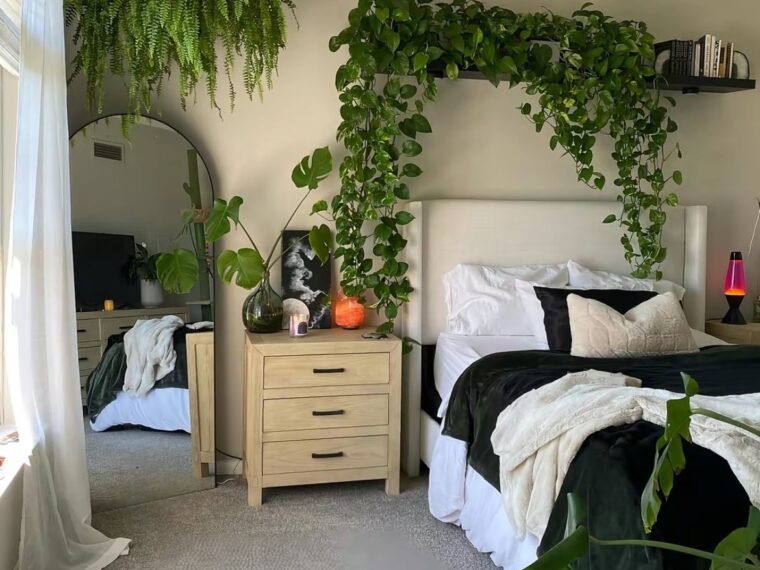We all face challenges like poor sleep, daily stress, and worries about indoor air quality. Thankfully, nature offers a simple, beautiful remedy: healing indoor plants. More than just decorative greenery, these plants actively purify the air, ease stress, and even promote better sleep — all vital for creating a healthier, calmer bedroom sanctuary.
Below, I’ve rounded up the best healing plants that thrive indoors, perfect companions to transform your bedroom into a fresh, tranquil retreat.
1. Aloe Vera
Aloe Vera is a superstar for bedroom wellness. Its succulent leaves bring a sense of calm and are incredibly easy to care for — thriving in bright light with minimal watering.
But Aloe Vera’s benefits go far beyond aesthetics. Known for its medicinal properties, its gel heals cuts, burns, and skin irritations. Placing Aloe Vera in your bedroom can subtly improve air quality by releasing oxygen at night, unlike most plants that absorb it. This makes it a great natural sleep aid.
Care tip: Water sparingly, allowing soil or roots to dry between watering. Position near a sunny window but out of direct harsh midday sun.
2. Lavender
Lavender’s soothing purple blossoms and calming fragrance have been cherished for centuries. Its scent acts like a gentle hug, helping to soothe nerves, reduce anxiety, and improve sleep quality.
The leaves contain essential oils with anti-inflammatory properties and can be brewed into calming teas or used as a natural insect repellent.
Care tip: Keep in bright, indirect light and water moderately to maintain fragrant blooms. Drying lavender flowers can provide a year-round calming sachet.
3. Snake Plant (Sansevieria)
If you’re new to plants or tend to forget watering, the snake plant is your perfect match. Its tall, sword-like leaves require very little care and are extremely hardy.
Even better, snake plants are powerful air purifiers, filtering out toxins like formaldehyde and benzene. They uniquely convert carbon dioxide into oxygen during the night, enhancing bedroom air quality while you sleep.
Care tip: Thrives in low to bright indirect light. Water only when soil is dry to avoid root rot.
4. Peace Lily (Spathiphyllum)
Peace Lilies offer elegant broad leaves and stunning white flowers that add a touch of serenity to any bedroom. They are natural air purifiers, effectively removing VOCs (volatile organic compounds) and carbon dioxide from the air.
Studies show Peace Lilies excel at cleaning indoor air and thrive in low to medium light—perfect for shady bedroom corners.
Care tip: Keep soil moist but not soggy. Remove wilted flowers promptly to encourage new blooms.
5. Chamomile
Chamomile is not just a tea favorite — it’s a charming bedroom plant that brings calming scents and gentle beauty with its daisy-like flowers.
It purifies the air and thrives in well-draining soil with sunny spots. Chamomile is low maintenance, needing only occasional watering and offering a peaceful environment conducive to rest.
Care tip: Grow near a window for plenty of light, water when soil is dry to the touch.
6. English Ivy
English Ivy is a powerful air purifier that can remove nearly 90% of airborne benzene — a common indoor pollutant. Its climbing vines and broad leaves create a lush, green presence that feels like bringing a bit of the outdoors inside.
Thriving in bright, indirect light with consistently moist soil, English Ivy can be grown in pots, hanging baskets, or trained on a trellis.
Care tip: Keep soil evenly moist but not waterlogged. Regular trimming helps maintain shape and encourages fuller growth.
7. Jasmine
Jasmine’s gentle, sweet scent is perfect for creating a serene, calming atmosphere conducive to restful sleep. Its flowers symbolize peace and relaxation, and the plant itself is versatile—ranging from 1 to 15 feet depending on the variety.
Jasmine thrives in bright, indirect light and prefers well-drained, moist soil.
Care tip: Ensure good air circulation to prevent mildew; water regularly but avoid soggy soil.
8. Spider Plant
Despite the name, spider plants won’t invite any creepy crawlies to your bedroom! Their dangling plantlets look like tiny spiders on webs but they are excellent natural air purifiers, capable of removing up to 95% of formaldehyde toxins.
Spider plants thrive in indirect light and need minimal watering, making them extremely beginner-friendly.
Care tip: Water moderately, allowing soil to dry slightly between watering. Provide bright, indirect light for best growth.
9. Lavender Rosemary
This dynamic duo combines the calming properties of lavender with the invigorating scent of rosemary. Lavender soothes stress and promotes better sleep, while rosemary boosts concentration and memory.
Together, they create a balanced atmosphere of relaxation and mental clarity in your bedroom.
Care tip: Plant in well-drained soil with full sun exposure; water moderately.
10. Gardenia
Gardenia adds elegance and a luxurious fragrance to your bedroom. With glossy green leaves and pure white blooms, it evokes the feeling of a serene luxury resort.
Gardenias thrive in medium to bright light, prefer moist, acidic soil, and can grow up to 4 feet tall.
Care tip: Keep soil moist and slightly acidic; protect from drafts and sudden temperature changes.
11. Golden Pothos
Golden pothos is a favorite trailing plant with heart-shaped leaves that purify air by reducing indoor ozone and removing VOCs. It tolerates medium to low light and occasional neglect—ideal for busy or forgetful plant owners.
Care tip: Water when soil feels dry to the touch and prune vines to encourage bushier growth.
12. Money Plant (Pilea peperomioides)
The charming Chinese money plant grows quickly under indirect sunlight and occasional watering. It purifies the air by filtering toxins like formaldehyde and is considered a symbol of luck and prosperity.
Care tip: Bright, indirect light with well-drained soil; water when the top inch of soil is dry.
13. Mint
Mint’s fresh, invigorating scent doubles as a natural air freshener, brightening your mornings. It also offers digestive and headache relief benefits.
Mint thrives in partial shade or full sun with well-drained soil and is easy to grow indoors.
Care tip: Water regularly to keep soil moist; pinch leaves to promote bushier growth.
14. Eucalyptus
Eucalyptus is not just visually striking; it improves respiratory health by acting as a natural decongestant and anti-inflammatory agent. Its essential oils promote relaxation and relieve stress.
Care tip: Provide bright, indirect light and keep soil moist but well-drained.
15. Gerbera Daisy
Want a pop of color and cleaner air? Gerbera daisies brighten bedrooms while removing toxins like benzene and formaldehyde.
They thrive in bright light and well-drained soil and reward you with vibrant, cheerful blooms.
Care tip: Water moderately, keeping soil moist but not soggy; deadhead spent flowers to prolong blooming.
16. Rosemary
Rosemary’s aromatic scent is refreshing and energizing. It has antioxidant properties and can enhance memory and digestion.
Care tip: Provide bright sunlight and well-drained soil; avoid overwatering.
General Tips for Growing Healing Bedroom Plants
- Light: Most of these plants prefer bright, indirect light — avoid harsh direct sun that can scorch leaves.
- Water: Avoid overwatering; check soil moisture regularly. Many plants thrive with watering only when soil is dry to the touch.
- Air Circulation: Good airflow prevents mold and mildew, which can harm plants and reduce air quality.
- Humidity: Some plants, like gardenia or eucalyptus, appreciate higher humidity; use a pebble tray or humidifier if your bedroom is dry.
- Clean leaves: Dust plant leaves gently with a damp cloth to maximize air-purifying effectiveness.
Final Thoughts
Integrating healing plants into your bedroom isn’t just about décor — it’s about creating a healthier, more restful sanctuary. Whether you choose the medicinal benefits of aloe, the calming scent of lavender, or the robust air-purifying power of snake plants, these green companions support your wellbeing naturally.
Start small with a favorite and watch as your indoor space transforms into a vibrant, serene retreat.





